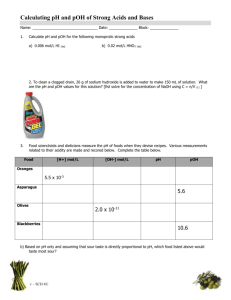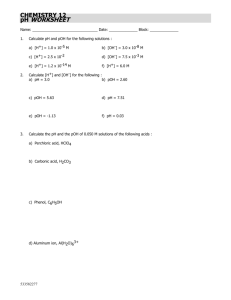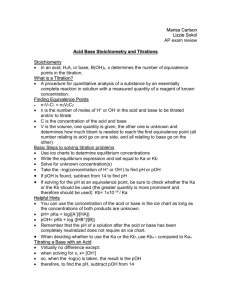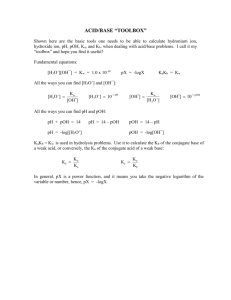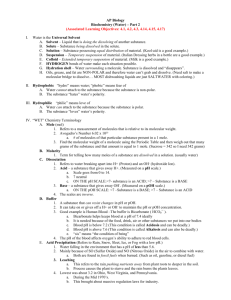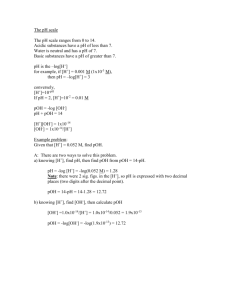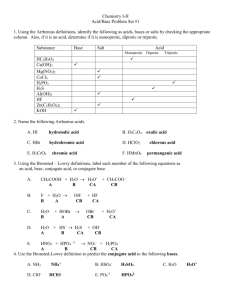Kw PowerPoint - Ion-product Constant - pH, pOH
advertisement
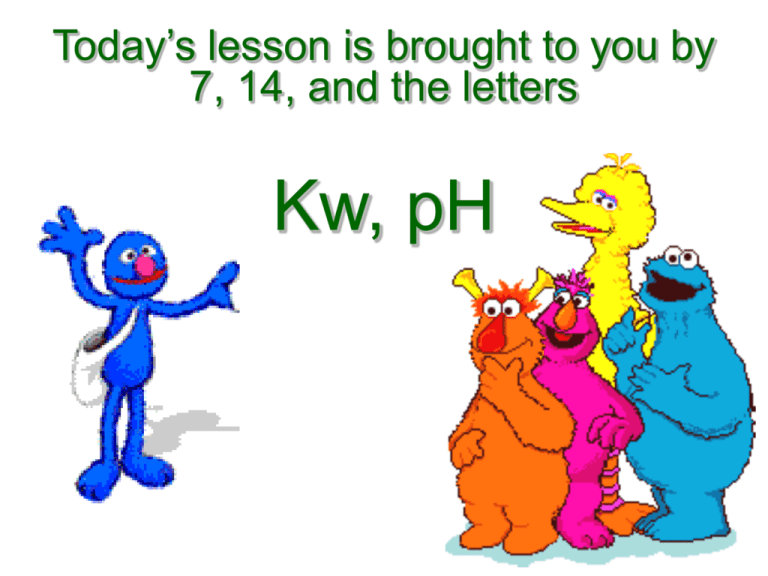
Today’s lesson is brought to you by 7, 14, and the letters Kw, pH Kw: the ion-product constant of water Q: will pure distilled water conduct electricity A: As the demo shows, it will (slightly). • If water conducts electricity, ions must exist • Water exists as an equilibrium, which is referred to as the self-ionization of water: H2O + H2O H3O+(aq) + OH–(aq) [H3O+] [OH–] or Kw = [H O+] [OH–] 3 Kc = [H2O]2 Simplified reaction: H2O H+(aq) + OH–(aq) [H+] [OH–] +] [OH–] [H or Kw = Kc = [H2O] Note: H+ is just shorthand for Kw • What is the value of Kw? • It has been measured at 1.0 x 10–14 (25 °C) • Notice (pg. 600) that by definition: when the solution is [H+] > [OH–] acidic [H+] < [OH–] basic [H+] = [OH–] neutral • Pure water is neutral since [H+] and [OH–] must be identical (both come from one H2O) • As temperature increases Kw increases Q: Rewrite the equilibrium of water with heat as a product or reactant (based on above point) Q: Do PE 1 (refer to example 15.1) Answers As temperature increases Kw increases. It must be that: H2O + heat H+ + OH– (increase temp = shift right = Kw) PE 1 Kw = [H+] [OH–] 1.0 x 10–14 = [H+] [7.8 x 10–6] [H+] =1.28 x 10–9 Thus, the solution is basic: [H+] < [OH–] pH • Notice (PE1) that a change in [H+] is matched by a change in [OH–], since Kw is constant (see middle columns of table 15.2 – pg. 603) • [H+] is commonly referred to because it is critical to chemical and biochemical reactions • A quick method of denoting [H+] is via pH • By definition pH = –log [H+] • The pH scale, similar to the Richter scale, describes a wide range of values • An earthquake of ‘6’ is10x as violent as a ‘5’ • Thus, the pH scale condenses possible values of [H+] to a 14 point scale • Also, it is easier to say pH=7 vs. [H+]=1x10–7 Calculations with pH • pH = –log [H+], what is pH if [H+] = 6.3 x 10–5? Enter 6.3 x 10–5 (‘6.3’, ‘exp’, ‘5’, ‘+/-’) Then hit ‘log’, followed by ‘+/-’ Ans: 4.2 • What is [H+] if pH = 7.4? • To solve this we must rearrange our equation [H+] = 10–pH mol/L Enter ’10’, ‘xy’, ‘7.4’, ‘+/-’, ‘=‘ 3.98x10–8 M • Finally, notice on pg. 603 that pH + pOH = 14 • This is related to Kw = 1.0 x 10–14 • You do not need to know how equations are derived; you need to know how to use them Equations and practice • You will need to memorize the following: [H+] = 10–pH [OH–] = 10–pOH pH = – log [H+] pOH = – log [OH–] pH + pOH = 14 • Read footnote on 601 about significant digits • Do PE 2 – 4 on pg. 605 • Use examples 15.2 – 15.4 as reference PE 2 answers c) pH = – log [H+] = – log [7.2x10-8] = 7.14 pOH = 14 – pH pOH = 14 – 7.14 = 6.86 (slightly basic) d) Ba(OH)2 Ba2+ + 2OH– b)pOH = – log [OH–] pOH = – log [OH–] = – log [0.0050] = – log [0.00070] = 2.3 = 3.15 pH = 14 – pOH pH = 14 - pOH = 14 – 2.3 =11.7 = 14 – 3.15 = 10.85 = – log [H+] = – log [0.020] = 1.6989 = 1.70 pH + pOH = 14 pOH = 14 – pH pOH = 14 – 1.70 =12.3 a)pH PE 3 answers a) [H+] = 10–pH = 10–2.90 = 1.29 x 10–3 mol/L pOH = 14 – pH = 14.00 – 2.90 = 11.1 [OH–] = 10–pOH = 10–11.1= 7.94 x 10–12 mol/L b) [H+] = 10–pH = 10–3.85 = 1.41 x 10–4 mol/L pOH = 14 – pH = 14.00 – 3.85 = 10.15 [OH–] = 10–pOH = 10–10.15 = 7.08 x 10–12 mol/L c) [H+] = 10–pH = 10–10.81 = 1.55 x 10–11 mol/L pOH = 14 – pH = 14.00 – 10.81 = 3.19 [OH–] = 10–pOH = 10–3.19 = 6.46 x 10–4 mol/L PE 3, 4 answers d) [H+] = 10–pH = 10–4.11 = 7.76 x 10–5 mol/L pOH = 14 – pH = 14.00 – 4.11 = 9.89 [OH–] = 10–pOH = 10–9.89= 1.29 x 10–10 mol/L e) [H+] = 10–pH = 10–11.61 = 2.45 x 10–12 mol/L pOH = 14 – pH = 14.00 – 11.61 = 2.39 [OH–] = 10–pOH = 10–2.39 = 4.07 x 10–3 mol/L PE 4 a) acidic, b) acidic, c) basic, d) acidic, e) basic Measuring pH • pH can be measured in several ways • Usually it is measured with a coloured acidbase indicator (see pg. 606) or a pH meter • Coloured indicators are a crude measure of pH, but are useful in certain applications • pH meters are more accurate, but they must be calibrated prior to use • Calibration means setting to a standard • A pH meter is calibrated with a solution of known pH often called a buffer • “Buffer” indicates that the pH is stable Using pH meters 1. Always rinse pH meter in distilled water prior to placing it in a solution (buffer or otherwise) 2. Place the pH meter in a buffer with about the same pH as that of your solution (4, 7, or 10) 3. Turn on the pH meter only when in solution • Start with with buffer 7. Hit “cal” once. • Wait upto a minute until it automatically sets • Rinse, dry, and place in second buffer (4/10) • Hit “cal” once. Wait until it automatically sets • There is no need to use “read”. 4. Measure the pH of your solution For more lessons, visit www.chalkbored.com
